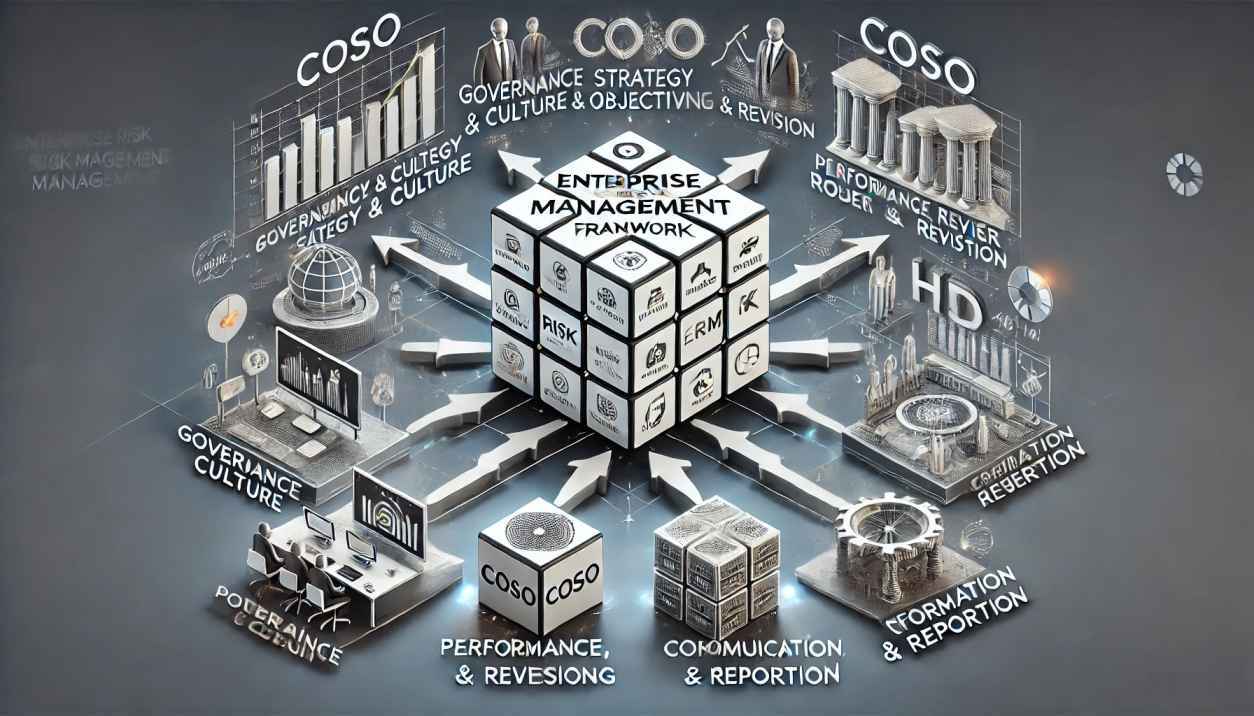When it comes to managing risk in an organized, reliable way, few tools are as respected as the COSO ERM Framework. Created by the Committee of Sponsoring Organizations of the Treadway Commission (COSO), this framework provides a structured, strategic approach to Enterprise Risk Management (ERM)—but what exactly does that mean?
Let’s break down what the COSO ERM Framework is, how it works, and why it’s become the global standard for managing risk, explained in simple terms.
What is the COSO ERM Framework?
The COSO ERM Framework is a set of principles and guidelines designed to help organizations identify, assess, manage, and monitor risk in alignment with their goals and values.
It’s not just about avoiding risk—it’s about understanding how risk affects performance, so companies can make informed, confident decisions.
Why It Matters
Organizations face risks every day—whether it’s from financial markets, cyber threats, supply chain issues, or operational breakdowns. The COSO ERM framework helps leaders:
- Spot potential threats before they happen
- Make risk-informed decisions
- Integrate risk management into strategy and planning
- Improve performance and accountability
It’s a proactive approach—not just a checklist.
A Quick Look at COSO’s Evolution
COSO originally focused on internal controls, releasing the Internal Control–Integrated Framework in 1992. As risk evolved, so did the need for a broader framework. That led to the 2004 COSO ERM Framework, later updated in 2017 as:
“Enterprise Risk Management: Integrating with Strategy and Performance”
This version emphasized that risk management must be embedded into every part of the organization—from planning to execution, not just an afterthought.
The 5 Components of COSO ERM
The 2017 COSO ERM Framework is built around five interrelated components, each one essential to managing risk effectively:
1. Governance and Culture
This is the foundation. It refers to how a company’s values, leadership, and ethical behavior shape how risks are identified and managed.
- Board oversight
- Leadership tone
- Ethical standards and core values
- Encouraging risk-aware culture
2. Strategy and Objective-Setting
You can’t manage risk without a clear goal. This component connects strategic planning with risk appetite, helping organizations set realistic objectives that consider risk from the start.
- Define mission and vision
- Set performance goals aligned with risk tolerance
- Understand external and internal environments
3. Performance
This part involves identifying and assessing risks that could affect performance—and making sure they’re managed properly.
- Risk identification and prioritization
- Risk response strategies
- Tracking performance vs. risk impact
4. Review and Revision
Things change. This component ensures the ERM process evolves with internal and external shifts.
- Evaluating ERM effectiveness
- Adjusting to market or regulatory changes
- Learning from past outcomes
5. Information, Communication, and Reporting
Good decisions depend on good data. This ensures risk-related info is shared openly and accurately across all levels of the organization.
- Transparent reporting
- Timely communication of risks and controls
- Integrated systems for data sharing
20 Principles Within the Framework
These five components are supported by 20 detailed principles, which guide how each part should function. For example:
- Demonstrate commitment to integrity and ethics
- Analyze business context
- Develop risk responses
- Communicate risk information effectively
- Review risk and performance together
You don’t need to memorize all 20—but knowing they exist provides a map for building a strong risk culture.
What Makes COSO ERM Unique?
Unlike other risk frameworks, COSO ERM ties risk management directly to strategy and performance. It treats risk as a value-driver, not just a hazard. The focus is not just on avoiding failure but on maximizing opportunity through smart risk choices.
Who Uses COSO ERM?
- Public and private corporations
- Government agencies
- Non-profits and NGOs
- Financial institutions and insurers
It’s used globally because it’s flexible and scalable—from startups to global enterprises.
COSO ERM in Action: A Simple Example
Imagine a company launching a new product:
- Governance and Culture: Leadership encourages open risk discussion
- Strategy: Product launch strategy is aligned with market risk appetite
- Performance: Risks like supply delays or competitor moves are assessed
- Review: Plans are adjusted after a market test shows low demand
- Communication: Teams are informed quickly to prevent losses
That’s COSO ERM at work—step-by-step integration of risk into everyday business.
Final Thought
The COSO ERM Framework isn’t just about managing risks—it’s about managing them intelligently and strategically. It helps organizations grow confidently, respond faster, and make better decisions.
In simple terms? COSO ERM makes risk work for you—not against you.
Explore Best Online Courses to Learn Risk Management
If you’re new to risk management or looking to deepen your expertise, there’s no better time to start than now. Learning from industry experts can help you build a strong foundation and gain certifications that set you apart in the job market.
At www.smartonlinecourse.com, in collaboration with the Risk Management Association of India (www.rmaindia.org), you can explore a range of self-paced, affordable online courses designed for both beginners and professionals. These courses are tailored to real-world needs, taught by experts, and designed for flexible learning.
👉 Visit www.smartonlinecourse.com to explore more!
📧 Email: info@smartonlinecourse.org
Or WhatsApp us at: 8232083010/9883398055


